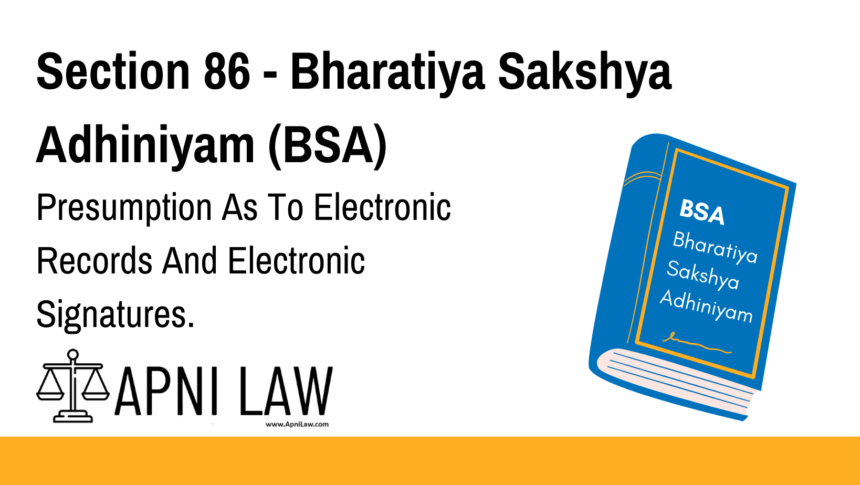Code: Section 86 – Bharatiya Sakshya Adhiniyam, 2023
(1) In any proceeding involving a secure electronic record, the Court shall presume
unless contrary is proved, that the secure electronic record has not been altered since the
specific point of time to which the secure status relates.
(2) In any proceeding, involving secure electronic signature, the Court shall presume
unless the contrary is proved that—
(a) the secure electronic signature is affixed by subscriber with the intention of
signing or approving the electronic record;
(b) except in the case of a secure electronic record or a secure electronic signature,
nothing in this section shall create any presumption, relating to authenticity and
integrity of the electronic record or any electronic signature.
Explanation of Section 86 BSA
Section 86 of the Bharatiya Sakshya Adhiniyam (BSA) deals with the legal presumption regarding secure electronic records and secure electronic signatures in court proceedings. The section provides two key presumptions:
-
Secure Electronic Records:
-
If a secure electronic record is involved in any legal proceeding, the court shall presume, unless proven otherwise, that the secure electronic record has not been altered since the specific time when it was marked as secure.
-
-
Secure Electronic Signatures:
-
When secure electronic signatures are involved, the court will presume, unless proved otherwise, that:
-
The secure electronic signature was affixed by the subscriber with the intention of signing or approving the electronic record.
-
-
This presumption does not extend to the authenticity or integrity of the electronic record or any electronic signature unless they are secured.
-
This section establishes a framework for the admissibility and presumed authenticity of secure electronic records and signatures in legal proceedings, simplifying the process for proving the integrity of digital evidence.
Illustration
Example 1: Secure Electronic Record in a Contract Dispute
In a dispute over a digital contract, the court receives a secure electronic version of the contract. The court presumes that the contract has not been altered since the time it was marked as secure, unless evidence to the contrary is provided.
Example 2: Secure Electronic Signature on a Loan Agreement
A subscriber electronically signs a loan agreement with a secure electronic signature. In the event of a legal proceeding, the court will presume that the signature was affixed with the intention of signing and approving the document, unless challenged.
Common Questions and Answers on Section 86 BSA
1. What does Section 86 say about secure electronic records?
Section 86 presumes that once a secure electronic record is created, it has not been altered unless proven otherwise. This gives credibility to the secure status of digital records in legal proceedings.
2. Can the presumption regarding the secure electronic signature be challenged?
Yes. The opposing party can provide evidence that the secure electronic signature was not affixed with the subscriber’s intention or that the record was altered after the secure status was applied.
3. Does this section address all types of electronic records and signatures?
No. Section 86 specifically addresses secure electronic records and signatures. It does not create presumptions for general electronic records or signatures that are not secured.
4. What does “secure” mean in this context?
In this context, a “secure” electronic record or signature refers to records or signatures that meet specific legal standards of integrity, authenticity, and security, such as those supported by encryption or digital certification mechanisms.
5. How does this presumption benefit the judicial process?
The presumption simplifies the process of proving the integrity and authenticity of electronic records and signatures in court, reducing the need for extensive verification procedures unless there is compelling evidence to the contrary.
Conclusion
Section 86 of the Bharatiya Sakshya Adhiniyam ensures that secure electronic records and signatures are presumed authentic in legal proceedings, unless proven otherwise. This streamlines the process of handling digital evidence and reinforces the reliability of electronic transactions in the legal domain.
For more structured legal insights, visit ApniLaw.








